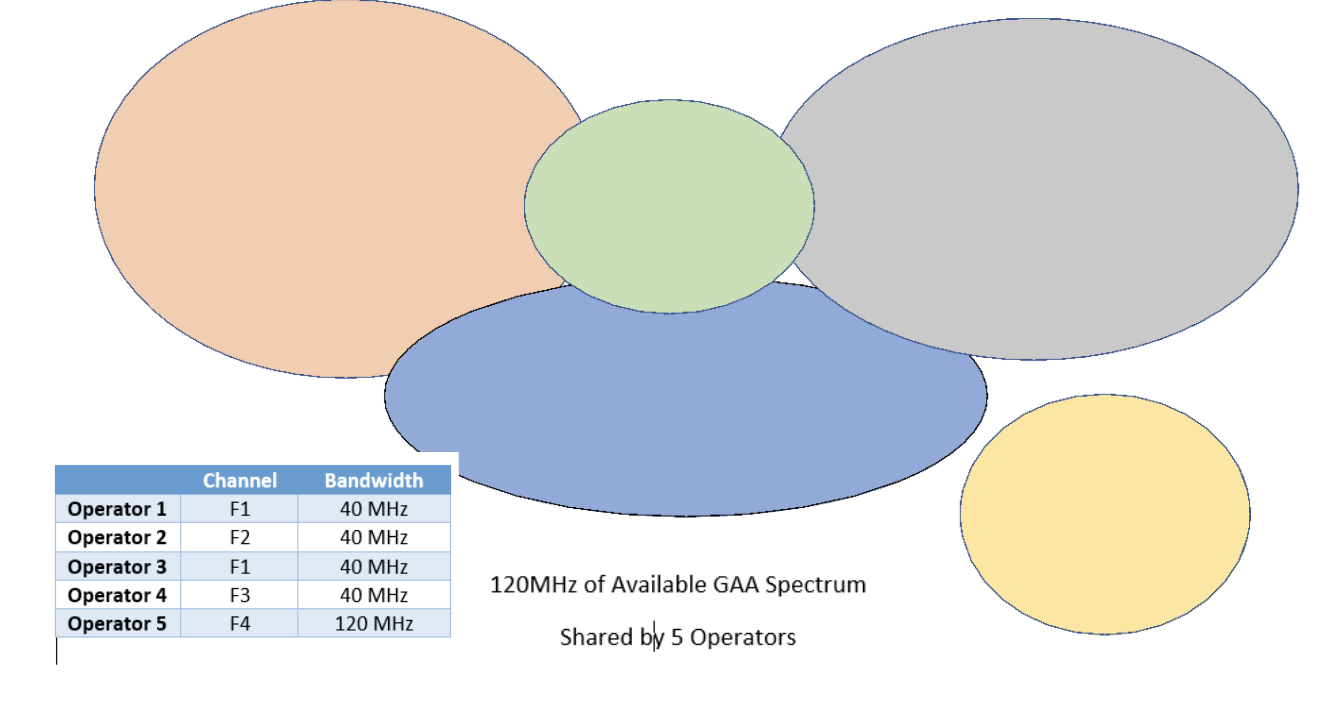Most people familiar with the Citizens Broadband Radio System (CBRS) understand the three-tiered sharing model that designates lightly licensed General Authorized Access (GAA) users to the bottom tier with the lowest level of priority. However, CBRS players are often surprised to learn that while the Federal Communications Commission (FCC) has formulated detailed rules for interference protection and methods for coordination between tiers – the Commission leaves it up to the GAA users to work out any interference issues with other users within that tier.
Specifically, FCC rule 96.35(c) states “General Authorized Access Users shall have no expectation of interference protection from other General Authorized Access Users operating in accordance with this part.” The FCC goes further in 96.35(e) stating: “General Authorized Access Users operating Category B CBSDs must make every effort to cooperate in the selection and use of available frequencies provided by an SAS to minimize the potential for interference and make the most effective use of the authorized facilities.” So, how does this work in practical terms? How do GAA CBSDs cooperate and coordinate their spectrum utilization? How do GAA users just get along? The answer lies in a method termed ‘GAA Coexistence’ by the CBRS community.
When we hear the word ’coexist,’ many of us may think of a colorful multi-cultural bumper sticker pasted on the bumper of the car in front of us as we hum down the road. Fortunately, it’s a similar concept in CBRS – all GAA users are allocated spectrum in a way that minimizes friction or interference with their neighbors.
Formulating the details around how this will work has been taken up by various CBRS industry groups. The CBRS Alliance (CBRSA), whose mission is to evangelize 3GPP based Radio Access Technology (RAT) for CBRS, started the ball rolling when they published technical specification for GAA Coexistence. WInnForum, which played a major role in developing requirements and specification for the CBRS ecosystem, has also published a RAT agnostic technical report that provides a framework for coexistence.
The CBRSA Coexistence Specification (CBRSA-TS-2001) applies to LTE and 5G-NR deployments. The spec first requires a level of TDD synchronization between Citizens Broadband Radio Service Devices (CBSDs). This helps to ensure that coexistence can be better managed by avoiding cross link or adjacent channel interference in the time domain. CBRSA defined a logical entity, called the Citizens Broadband Radio Service Device ’Coexistence Manager,’ to provide coexistence oversight. CBSDs that wish to play in the CBRSA’s coexistence game must register themselves as part of a CBRS Alliance coexistence group.
Under the CBRSA coexistence group, a CBSD can elect to be part of an Interference Coordination Group (IGC) and a Common Channel Group (CCG). Registering as part of an ICG tells the SAS that all operator CBSDs within this group are capable of managing interference by themselves – and do not require the SAS to provide non-interfering channel assignments. CBSDs that elect to be part of a CCG inform the SAS that all members must receive the same frequency assignment. WinnForum has also defined a Spectrum Reuse Group (SRG) which is like an ICG but applies to RAT agnostic devices.
CBRS-A specifications further define coexistence measurement reports, such as RF signal level measurements, that the CBSD provides to the SAS to assist with channel assignments. These are used by the SAS as a modeling improvement over using just a propagation estimate alone.
To decide how to allocate GAA spectrum, the SAS determines the pairwise potential interference situations between CBSD(s) or groups of CBSD(s). Essentially, the SAS determines which CBSDs have overlapping coverage – and if those CBSDs are part of an ICG, CCG or SRG. An interference graph is then constructed. By applying methods of graph theory, the SAS can determine how many unique frequency blocks are needed for this CBSD group and how to optimally divide the available spectrum for primary allocation purposes into orthogonal and equal frequency blocks.
The figure below provides an illustrative example. Five operators have CBSDs deployed in a common area with an existing PAL Protection Area (PPA) in the vicinity which occupies 30 megahertz – hence a remaining 120 megahertz is free for GAA use. Four of these operator networks have some overlap in coverage. The SAS determines that three unique frequencies are required to provide co-channel interference-free service and divides up the available 120 megahertz spectrum equally among the four operators with overlapping coverage by assigning a 40 megahertz primary channel allocation. The fifth operator, which does not overlap in coverage with the other four, is assigned a primary channel allocation of the full 120 megahertz.

Release 1 of the WinnForum protocol already includes the Operational Parameters object and the Spectrum Inquiry message which is what the SAS will use to direct the CBSD to its computed coexistence channel frequency. Release 1 also incorporates the measurement reports fields to carry data on power measurements performed by the CBSD.
We expect coexistence to hit the field in early 2021. It will likely be deployed in phases, with new capability added in each phase. There are still some details that are being worked out across the SAS administrators to reach the final phase, such as interference graph sharing and channel reconciliation. CBSD vendors will also make changes required to interface with SAS administrators supporting coexistence functionality. And finally, we need critical mass. Coexistence is optional and there needs to be enough vendors who want to enter the game for it to be fair for all. If we don’t have enough participants jump in, everyone will suffer from an uncoordinated and inefficient use of GAA spectrum. So, push your team to implement coexistence!
The post Understanding the CBRS coexistence paradigm (Reader Forum) appeared first on RCR Wireless News.
